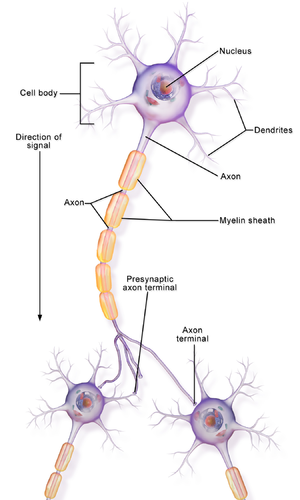Interneurons (also known as association neurons) are neurons that are found exclusively in the central nervous system. ie Found in the brain and spinal cord and not in the peripheral segments of the nervous system. There are more than 100 billion interneurons in the human body, which makes them the most abundant of the three major neuron types (along with sensory and motor neurons). This abundance of interneurons is due to the complexity of integrating the sensory and motor segments of the nervous system and the diversity of functions that exist in the brain and spinal cord.
- Interneurons acts as a “middle-man” between afferent, or sensory, neurons, which receive signals from the peripheral nervous system, and efferent, or motor, neurons, which transmit signals from the brain. It also connects to other interneurons, allowing them to communicate with one another.
- Interneurons form key nodes within neural circuitry in the brain and help regulate neuronal activity by releasing the neurotransmitter GABA, which inhibits the firing of other neurons.
Structure and Function
The central nervous system, including the brain, contains many interneuron. In the neocortex (making up about 80% of the human brain), approximately 20-30% of neurons are interneurons.
Interneuron can be broken down into two groups: local interneuron and relay interneuron.
- Local interneuron has short axons and form circuits with nearby neurons to analyze small pieces of information.
- Relay interneurons have long axons and connect circuits of neurons in one region of the brain with those in other regions. The interaction between interneurons allows the brain to perform complex functions such as learning, and decision-making.
 |
| Interneurons |
Interneurons are multipolar nerve cells (see image), meaning that they have more than one dendrite. Although they are found throughout the brain, each one is confined to a particular region: they do not connect different parts of the brain to one another. They come in a much greater variety of forms than afferent or efferent nerve cells, but, as of 2013, there is no standard method of classifying them into types.
As with all neurons, interneurons are able to stimulate tissues through the use of neurotransmitters, or chemical messengers; however, for the purpose of integration, interneuron utilizes different neurotransmitters than the peripheral nervous system uses. Typically, interneuron will release glutamate, an excitatory neurotransmitter, to activate tissues in a reflex response. Similarly, they may utilize gamma-aminobutyric acid (GABA) when inhibition of tissue is necessary.
The inhibitory signals they produce may serve to modulate electrical stimuli between afferent and efferent nerve cells, but they also seem to play many other essential roles. Large assemblies of different types of these nerve cells appear to interact in complex ways that are important to higher brain functions such as memory, perception and emotion.
Role in Locomotor Movement
Spinal interneuron (IN) circuits ensure coordinated spatiotemporal muscle contractions necessary for complex locomotor behaviors.
- Locomotor movement has enabled vertebrate species to both survive and thrive for millions of years by empowering navigation through dynamic environments across land, sea, and air.
- Spinal interneurons (INs) form the basic motor circuits that ensure coordinated spatiotemporal muscle contractions.
- Distinct IN populations organize into functionally hierarchical modular circuits producing complex locomotor schemes – such as chewing, scratching, swimming, and walking
Cognitive Role
Interneurons in the neocortex and the hippocampal formation have have been seen as something which plays auxiliary roles in the organization of brain activity and consequently in cognitive functions. Interneurons, mostly inhibitory ones, are believed to be designed to prevent instability of the brain system by inhibition. It is sometimes believed also that interneurons form local or micro circuitries in the neocortex, and are fed locally by nearby “principal” (pyramidal) neurons.
Recent experimental data suggest that such our picture of interneurons should undergo a fundamental change. Interneurons may play essential roles in the organization of brain activity through interplay with pyramidal systems. Interneurons in the neocortex and hippocampus exhibit a large diversity in morphology, firing properties and biochemical patterns of coexpression and may form discrete networks, although their classification is largely controversial.


0Comments